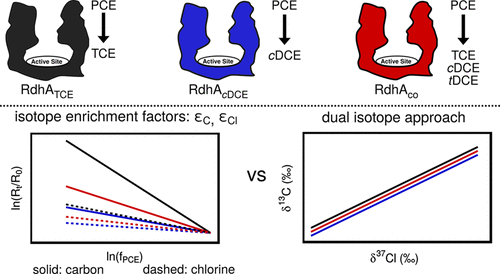当前位置:
X-MOL 学术
›
Environ. Sci. Technol.
›
论文详情
Our official English website, www.x-mol.net, welcomes your
feedback! (Note: you will need to create a separate account there.)
Deciphering the Variability of Stable Isotope (C, Cl) Fractionation of Tetrachloroethene Biotransformation by Desulfitobacterium strains Carrying Different Reductive Dehalogenases Enzymes.
Environmental Science & Technology ( IF 10.8 ) Pub Date : 2020-01-13 , DOI: 10.1021/acs.est.9b05606 Johannes Büsing 1 , Daniel Buchner 1 , Sebastian Behrens 2 , Stefan B Haderlein 1
Environmental Science & Technology ( IF 10.8 ) Pub Date : 2020-01-13 , DOI: 10.1021/acs.est.9b05606 Johannes Büsing 1 , Daniel Buchner 1 , Sebastian Behrens 2 , Stefan B Haderlein 1
Affiliation

|
Kinetic isotope effects have been used successfully to prove and characterize organic contaminant transformation on various scales including field and laboratory studies. For tetrachloroethene (PCE) biotransformation, however, causes for the substantial variability of reported isotope enrichment factors (ε) are still not deciphered (εC = -0.4 to -19.0‰). Factors such as different reaction mechanisms and masking of isotope fractionation by either limited intracellular mass transfer or rate-limitations within the enzymatic multistep reaction are under discussion. This study evaluated the contribution of these factors to the magnitude of carbon and chlorine isotope fractionation of Desulfitobacterium strains harboring three different PCE-transforming enzymes (PCE-RdhA). Despite variable single element isotope fractionation (εC = -5.0 to -19.7‰; εCl = -1.9 to -6.3‰), similar slopes of dual element isotope plots (ΛC/Cl values of 2.4 ± 0.1 to 3.6 ± 0.1) suggest a common reaction mechanism for different PCE-RdhAs. Cell envelope properties of the Desulfitobacterium strains allowed to exclude masking effects due to PCE mass transfer limitation. Our results thus revealed that different rate-limiting steps (e.g., substrate channel diffusion) in the enzymatic multistep reactions of individual PCE-RdhAs rather than different reaction mechanisms determine the extent of PCE isotope fractionation in the Desulfitobacterium genus.
中文翻译:

破译携带不同还原性脱卤素酶的脱硫细菌菌株对四氯乙烯进行生物转化的稳定同位素(C,Cl)馏分的变异性。
动力学同位素效应已成功用于证明和表征各种规模的有机污染物转化,包括现场和实验室研究。然而,对于四氯乙烯(PCE)的生物转化,仍未解释所报道的同位素富集因子(ε)的实质性变化的原因(εC= -0.4至-19.0‰)。诸如酶联多步反应中有限的细胞内传质或速率限制等不同反应机制和同位素分馏掩盖等因素正在讨论中。这项研究评估了这些因素对具有三种不同PCE转化酶(PCE-RdhA)的脱硫细菌菌株的碳和氯同位素分馏程度的贡献。尽管单元素同位素分级可变(εC= -5.0至-19.7‰; εCl= -1.9至-6.3‰),双元素同位素图的相似斜率(ΛC / Cl值为2.4±0.1至3.6±0.1)表明了不同PCE-RdhAs的共同反应机理。脱硫杆菌属菌株的细胞被膜特性可以排除由于PCE传质限制而产生的掩盖效应。因此,我们的结果表明,单个PCE-RdhAs的酶促多步反应中的不同限速步骤(例如,底物通道扩散),而不是不同的反应机制,决定了脱硫杆菌属中PCE同位素分级分离的程度。脱硫杆菌属菌株的细胞被膜特性可以排除由于PCE传质限制而产生的掩盖效应。因此,我们的结果表明,单个PCE-RdhAs的酶促多步反应中的不同限速步骤(例如,底物通道扩散),而不是不同的反应机制,决定了脱硫杆菌属中PCE同位素分级分离的程度。脱硫杆菌属菌株的细胞被膜特性可以排除由于PCE传质限制而产生的掩盖效应。因此,我们的结果表明,单个PCE-RdhAs的酶促多步反应中的不同限速步骤(例如,底物通道扩散),而不是不同的反应机制,决定了脱硫杆菌属中PCE同位素分级分离的程度。
更新日期:2020-01-13
中文翻译:

破译携带不同还原性脱卤素酶的脱硫细菌菌株对四氯乙烯进行生物转化的稳定同位素(C,Cl)馏分的变异性。
动力学同位素效应已成功用于证明和表征各种规模的有机污染物转化,包括现场和实验室研究。然而,对于四氯乙烯(PCE)的生物转化,仍未解释所报道的同位素富集因子(ε)的实质性变化的原因(εC= -0.4至-19.0‰)。诸如酶联多步反应中有限的细胞内传质或速率限制等不同反应机制和同位素分馏掩盖等因素正在讨论中。这项研究评估了这些因素对具有三种不同PCE转化酶(PCE-RdhA)的脱硫细菌菌株的碳和氯同位素分馏程度的贡献。尽管单元素同位素分级可变(εC= -5.0至-19.7‰; εCl= -1.9至-6.3‰),双元素同位素图的相似斜率(ΛC / Cl值为2.4±0.1至3.6±0.1)表明了不同PCE-RdhAs的共同反应机理。脱硫杆菌属菌株的细胞被膜特性可以排除由于PCE传质限制而产生的掩盖效应。因此,我们的结果表明,单个PCE-RdhAs的酶促多步反应中的不同限速步骤(例如,底物通道扩散),而不是不同的反应机制,决定了脱硫杆菌属中PCE同位素分级分离的程度。脱硫杆菌属菌株的细胞被膜特性可以排除由于PCE传质限制而产生的掩盖效应。因此,我们的结果表明,单个PCE-RdhAs的酶促多步反应中的不同限速步骤(例如,底物通道扩散),而不是不同的反应机制,决定了脱硫杆菌属中PCE同位素分级分离的程度。脱硫杆菌属菌株的细胞被膜特性可以排除由于PCE传质限制而产生的掩盖效应。因此,我们的结果表明,单个PCE-RdhAs的酶促多步反应中的不同限速步骤(例如,底物通道扩散),而不是不同的反应机制,决定了脱硫杆菌属中PCE同位素分级分离的程度。











































 京公网安备 11010802027423号
京公网安备 11010802027423号